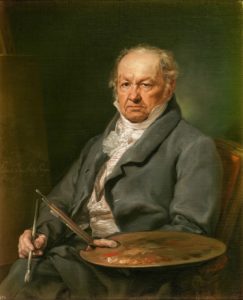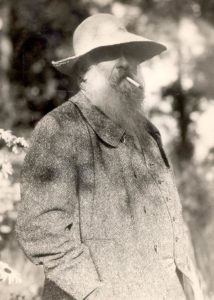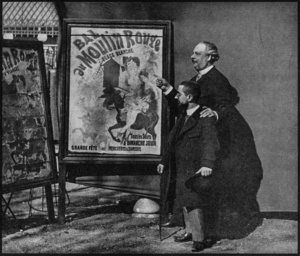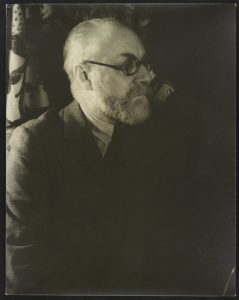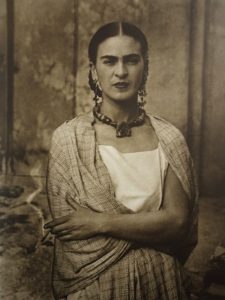Not being like everyone else is often seen as something negative, something that withholds you from the experiences that everyone else gets to have. This is especially true for people with illnesses and disabilities. But studying the lives of great artists can tell us something: sometimes, living with a chronic illness or a lifelong disability can enable you to see the world differently. These are the great artists who changed art forever, not despite their conditions but often because of them.
Francisco de Goya
Francisco de Goya is considered one of the greatest, most influential Spanish painters ever. Known primarily for his work in the service of the Spanish royal family, he is also known for his work showing scenes from the Peninsular War, when Napoleon’s armies invaded Spain. However, he is also known for his darker, more fantastical scenes from his later life. In the 1790s, Goya began experiencing chronic headaches, dizziness, loss of mobility in his right arm, and issues with his hearing. He began to lose weight, he grew depressed, and sometimes he would experience hallucinations. Some believe that these symptoms were the result of several contributing factors, including syphilis, which Goya treated using mercury. Furthermore, the paints he used often contained lead, which I’m sure didn’t exactly help. This culminated in his best-known work from his later life: the Black Paintings. These were a series of murals painted on the walls inside his house just outside of Madrid. They are dark, mysterious works, often dealing with subjects like fear, evil, darkness, violence, and monsters.
The most famous of the Black Paintings is Saturn Devouring his Son. This is the Spaniard’s take on the classic Greco-Roman myth of the titan Saturn (or Kronos in Greek) consuming his children to prevent them from overthrowing him, just as he had done to his own father. Normally, retellings of the story show Saturn swallowing his children since he later vomits them back up to join with their brother Jupiter and fight their father. But here, we see a haggard-looking, crazy-eyed being gorging himself on the body of his child. After Goya died in 1828, the Black Paintings were removed from the house’s walls and attached to canvases, which have since been displayed at the Prado Museum in Madrid. Other paintings in the series include The Witches’ Sabbath, Judith Beheading Holofernes, and a scene with two men dueling each other with clubs. Many scholars believe that the horrors of the Peninsular War, combined with the effects of his illness, led to Goya’s fixation on humanity’s darkness, leading to some of his most iconic, harrowing paintings. As a look into the mind of an old, tired man, these dark, haunting works no doubt helped to shape aspects of Romanticism in the century to come.
Claude Monet
When I often try to explain what Impressionism was, I tend to break it down and simplify it as “They made stuff blurry.” Of course, it’s more complicated, but this form of abstraction came about because these painters wanted to create their works en plein air as quickly as possible to capture a specific moment. Being a founding member of the Impressionist group, Claude Monet’s works are often held up as quintessential examples of the style. His early Impressionist works from the 1870s, like Impression, soleil levant and Woman with a Parasol, made a great impact on generations of painters. Yet when you say the name Monet to a random person, chances are they’ll only think of one thing: the water lilies of his later career.
Monet began painting the water lilies from the pond on his property in Giverny in 1897. Throughout his career, he was fond of creating large series of works dedicated to a single subject, like a theme, and variations. Each painting was often slightly different depending on the light, the time of day, or the season. Before focusing on the water lilies, he had made series of paintings featuring haystacks and the façade of Rouen Cathedral. By the time he came to the water lilies, however, he was in his mid-fifties, and Monet’s vision started to fail. He had experienced vision problems before, but they had mainly been temporary. In 1905, he finally admitted that his sight wasn’t what it once was. Many of the water lilies paintings seem perhaps a little less vibrant than before. Monet began wearing a large-brimmed straw hat when painting outdoors, which he only did at dawn or dusk since his eyes could no longer handle intense sunlight. It’s estimated that by 1922, he was legally blind due to cataracts. The aging master was afraid to undergo surgery, especially since his friend Mary Cassatt underwent eye surgery that failed and led to the end of her artistic career. Monet continued to paint the water lilies, but he was losing the ability to see cool tones like blue and green. Hence, many of the paintings from this time seem more muted, with yellows and browns gaining a more prominent place on the canvas. He was also using more broad, thick brushstrokes, only increasing the level of abstraction.
Monet eventually underwent surgery on his right eye in 1923, which seemed to improve his vision, along with the help of specialized glasses. He continued painting the water lilies until he died in 1926. However, his eyesight’s deterioration, something any artist would dread, led to something quite different. The Water Lilies series, even those with muddier colors and imprecise brushstrokes, influenced generations of modern artists for decades to come. You can see how Monet’s disability became a great boon and an inspiration for painters like Jackson Pollock and Frank Auerbach.
Henri de Toulouse-Lautrec
Henri de Toulouse-Lautrec is often considered one of the most prolific post-impressionist artists alongside Van Gogh and Gauguin. He is best known for chronicling daily life in Paris, specifically its nightlife. He frequently visited the cafés, cabarets, and dance halls in the city, creating paintings and prints of their patrons and the performers, sometimes as advertisements on behalf of the venues. Toulouse-Lautrec was noticeably short, the result of several things converging at once. He came from an aristocratic family in southern France, with his father being a Count. Being aristocrats, his parents were first cousins, so right off the bat, not looking good. His parents’ close relation may have led to him having an unknown disorder that many say was likely pycnodysostosis. This condition often results in either abnormally dense bones or incredibly brittle bones. His condition affected him greatly after he broke both of his femurs in separate incidents about a year apart. The bones could not heal properly and later resulted in his legs failing to grow with the rest of his body as he aged. This meant he ended up with a full-grown torso but with very short legs, reaching only 4’8” by adulthood. Because of his injuries, he spent a good deal of his childhood in hospitals, with his parents even taking him to Lourdes to visit the Catholic shrine there. Even before his accidents, he displayed a fondness for drawing and painting, activities that he delved into further while immobilized.
Henri Matisse
Like Claude Monet, Henri Matisse began to suffer the consequences of old age. However, unlike Monet, who suffered from his own denialism and despair, Matisse found newfound energy through his disability. In 1941, Matisse underwent surgery to remove a cancerous tumor. He would remain in a wheelchair for the rest of his life. However, rather than mourn his loss of mobility, Matisse embarked on what he would later call his seconde vie, or a second life. It was his lack of mobility that enabled him to appreciate the world immediately around him more greatly. He began experimenting with new media, most famously his paper cut-outs. Matisse also created an implement to which he could attach pens, pencils, chalk, and other drawing utensils to reach the surface upon which he was working. This was how he was able to create countless works, including the interior of the Rosary Chapel in Saint-Paul-de-Vence.
Frida Kahlo
Frida Kahlo and Toulouse-Lautrec were remarkably similar in how they became artists. Before becoming an artist full-time, Kahlo pursued a career in medicine. On September 17, 1925, at the age of eighteen, she and a friend boarded a bus in Mexico City to return home from class. The bus made a turn and accidentally collided with an electric trolley car. Several people were killed. Though Kahlo survived, she suffered from extensive injuries. She broke her right leg, collarbone, and pelvis; and dislocated a foot and shoulder. Her spine was broken in three places, and the bus’s handrail had impaled her through the abdomen. She remained bedridden for two years while recovering, and suffered from chronic pain for the rest of her life due to the accident.
Frida thought of medicine as her future career, while painting had always been a hobby. During her two years in bed, she started painting more and more to pass the time. When fully healed, she started painting full-time and began getting involved in politics, which is how she met some of Mexico’s great muralist painters, including her future husband Diego Rivera. From then on, her body as well as her physical and psychological pain were frequent subjects in her paintings. She even references her injuries in several paintings, the most famous of which is The Broken Column from 1944.

